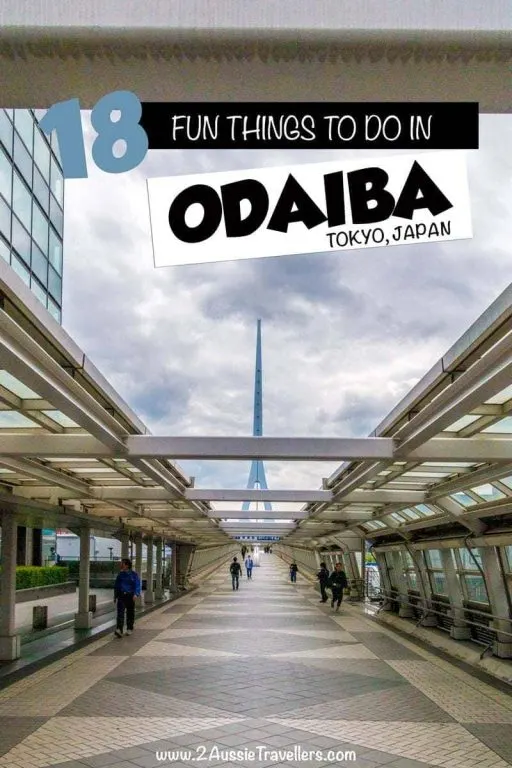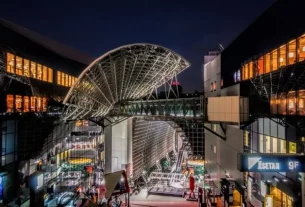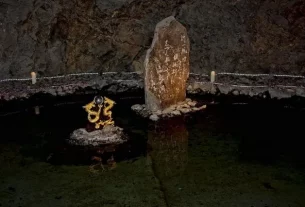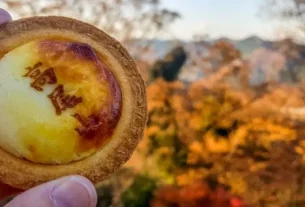One thing is for sure, you won’t run out of things to do in Odaiba. It’s a shopping and entertainment extravaganza built on 100% reclaimed land. Make sure you allocate a day to explore all that this futuristic and fun part of Tokyo has to offer.

Tokyo is a huge and sprawling city. It can be tough for first-time visitors to decide where to base yourself, what to see and how to use your time efficiently. Odaiba is one of those areas we’ve meant to get to a few times now and it’s just not happened.
This visit we were determined to do it justice and headed over there for the day. We quickly found there were more than a day’s worth of things to do and ended up adding a second day to try out a few more of the activities.
Now some will say Odaiba is ‘not the real Tokyo’ just as there are those that will say Tokyo is ‘not the real Japan’. In our view it’s all part of the experience, some parts of the country are more traditional, others focus on food or nature, anime is a big thing in some parts while others are business districts. It’s all the real Japan, just different aspects of it and for us, that is what makes this land of contrasts such a fabulous place to return to. We’ve put together this guide to help you decide if it’s something you want on your itinerary and to help you focus on the parts that appeal to you.
If you have decided to base yourself in Tokyo we recommend reading our articles on our 50 top things to do in Tokyo and the best day trips from the city. We’ve regularly spent time in and around Tokyo for more than a decade now and these are genuinely our personal favourites. If you have any questions please feel free to reach out through the comments below or our 2 Aussie Travellers Facebook Page.
Table of Contents
Things to do in Odaiba
1. Walk the waterfront
Walking the promenade along the waterfront of Odaiba is a unique Tokyo experience. Although the city itself is built around Tokyo Bay the land has been reclaimed and used commercially right to the water’s edge so this is the only beachfront promenade in Tokyo. It’s only a short train ride across the bridge from Shimbashi but you feel like you’re a world away from the city. While you wouldn’t call Odaiba getting away from it all it does provide a fun change of pace.

2. Visit the historic fort
Odaiba is a 100% manmade island in Tokyo Bay that evolved in the early 1990s. From its creation, it was intended to the be Teleport town that it has become today profiling futuristic living, both commercial and residential.
Its foundation and name were inspired by the original 6 forts, or daiba, that were built here in the bay from 1853 as defensive positions for gun batteries. Today a causeway links the original number 3 battery to Odaiba and you can walk around the old fort.
It’s an elongated manmade island with a valley in the centre so during wartime all activity was hidden from view except for the battery gun placements that are still defined on the seaward facing high point. Today it’s a grassy green space that is popular for its cherry blossom during the spring season.

3. Man-made beach
The 800-metre-long beach on the Odaiba waterfront is carefully manicured with white sand and is a nice place to sit out in the sun or let the kids play for a while. It’s a great outlook to sit with a morning coffee making it easy to forget that it’s not a natural beach. The sand is shipped in and you are in the midst of the harbour so there’s no swimming and fishing allowed.

4. Unicorn Gundam Statue
Stop by DiverCity Tokyo Plaza to find the new unicorn ‘life-size’ Gundam statue. At 19.7 metres it towers over the passers-by in a way that Godzilla never did. This new bigger and better version was opened in 2017 and in true transformer fashion, it switches between its unicorn and destroyer modes several times a day.
For those that are asking what is a Gundam and why do I care? It’s similar to the Transformers series, both were created in Japan but for some reason, Gundam took off in Asia while our Aussie kids are probably more familiar with the Transformers. If they like Transformers they’ll love it.
A bit of a spoiler alert but useful if you want to see him transition, be around at 11 am, 1 pm, 3 pm or 5 pm. It’s all over pretty quickly so be ready. In the evening the show continues with his defender panels lit up and glowing.

5. Statue of Liberty
At not much more than a quarter of the size of the NYC Statue of Liberty statue, the Odaiba one is just 12.25 meters high but its placement makes it seem deceptively dominant in the landscape.
What I was most surprised to learn on this trip is that Lady Liberty has nothing to do with the USA despite the number of American-themed restaurants and cafes that overlook it. The statue was originally placed here in 1998 on loan for one year from France. It was given to celebrate relations between the two countries. It turns out that when it left it was missed so much that it was returned for good in 2000.

6. Takoyaki Museum
Takoyaki, along with my much-loved Okonomiyaki, has to be one of Osaka’s great gastronomy creations. Here in Odaiba’s DECKS Tokyo beach shopping centre, they have a Takoyaki museum. It’s a food hall of takoyaki vendors offering different styles and specialties from around the country.
The variations might have been exaggerated a little in the interest of making their offerings distinct but after trying a few plates from a couple of vendors we’d have to say these are pretty darn good. It’s well worth making a stop for a snack if not lunch.

7. Shop for (or with) your pooch
Venus Fort within the Palette Town Mall is a favourite with shoppers, its fountains and distinctive design give it a Caesars Palace feel that’s worth stopping in to see.
Level One is also an absolute haven for dog owners and lovers in Tokyo. It has the cutest shops of doggy accessories and treats but you can bring your beloved pooch shopping, to the salon and out to lunch with you in many of the shops and restaurants. Doggy-welcome cafes and areas are marked.
We have noticed throughout the city parks and green spaces that Japan has the best selection of designer doggy carry bags, backpacks and pushchairs, this looks like the place to shop for them.
8. Ride the driverless train
Aside from being a mode of transport into Odaiba, the Yurikamome line is a must-do in its own right. It’s a driverless train that’s useful for getting around between stations within Odaiba but the highlight has to be crossing the Rainbow Bridge to the terminal station at Shimbashi, not far from Ginza in the heart of Tokyo.
While classed as a ‘subway’, the train runs overhead with some great views along the way. It’s modern and runs on tyres, not tracks making for a smooth quiet ride.
For the best experience aim for the front row of the first carriage and get an unobstructed view out in front. During peak periods it can be busy but during the day it’s not too bad and you have a fair chance of getting up close to the front.

9. Ferris Wheel
When the Daikanransha Odaiba Ferris wheel opened in 1999 it was the world’s tallest, although no longer in the top 10 it is still one of the tallest in the world and offers some great views over Odaiba and Tokyo beyond. On a clear day, you can see as far as the Boso Peninsula and Mt Fuji during the 15-minute ride.
Always on the lookout for a unique perspective on a city, we decided to do the ride on the spur of the moment and really enjoyed it. It helps to get your bearings on Odaiba for the rest of the day.

10. Explore the parks
Odaiba is small enough to walk around but big enough that you won’t run out of things to do. Parklands run all around the outside following the waterfront and a wide park strip through the centre. You can see it fairly well from the photo taken in the Ferris wheel above, the 3rd battery and Rainbow Bridge are out to your right from here just outside the photo.
There are subway stops near most of the major attractions but you can easily explore Odaiba on foot too and between the overhead walkways and parklands you can avoid the major roads giving the place quite a relaxed vibe.
11. Take the futuristic boat to Asakusa
We did this trip a couple of years back when it was running from the other side of the river, not far from the Tsukiji markets. It still runs the same course up the Sumida River to Asakusa but I think basing it from Odaiba now is a big improvement.
It fits well into a day plan doing the two parts of the city and works equally well in either order depending on where you want to start and end your day. You can explore the cultural aspects of the low city of Asakusa and then take a step into the futuristic fun of Odaiba. Both have great daytime and evening attractions and dining options and the ride down the river gives an interesting new perspective on the city. We did it during the cherry blossom season when the river banks were decorated by the pink blooms but any time of year would work.
Read more about our Sumida River cruise | Check ticket prices and times

12. Mega Web
Megaweb is Toyota’s theme park and it’s not only for the petrol heads in the family. It’s an interactive museum taking you on a journey from the automobile’s history to the future. Some sections enable you to view, touch and experience from the technology zone to GR racing and a 1.3 km long driving course. Find out more here.

13. Oedo Onsen
The Odaiba Tokyo Oedo-Onsen Monogatari is an interesting concept. It’s a Japanese-style hot spring spa (onsen) experience within Tokyo city involving the ritual and relaxation but being located on reclaimed land there are no natural mineral hot springs to tap into so the pools are heated tap water and therefore can’t offer the remedial benefits of a mineral spring.
Read more reviews on TripAdvisor.
14. The best perspective on the Rainbow Bridge
The closest you can get on foot to the Rainbow Bridge is to walk out onto the 3rd Battery but there are great perspectives on it from many spots around the shoreline and buildings of Odaiba. You crossed this bridge if you took the driverless train from the city and most likely if you crossed by car or bus. Like much of Odaiba, it’s lit up at night and comes into its own then, that’s when it’s clear why it’s known as the ‘rainbow’ bridge.

15. Fuji TV Building
A distinctive part of the Odaiba skyline is the Fuji TV building. In addition to being the headquarters of Fuji TV, one of the Japan nationwide TV networks there is also a public observation deck on level 25 accessed through a series of escalators.
Architect Kenzo Tange took the ‘futuristic’ brief to heart when he designed this Pritzker prize-winning building that looks like a spaceship has docked on the roof. It’s also a fun part of Odaiba at night when the orb lights up with colour. Kenzo is one of Japan’s most well-known architects for his work in redesigning post-war Hiroshima including the museum and peace park layout.

16. Museum of Maritime Science
Modelled after the QEII cruise liner the ship-shaped museum has 6 floors split into 5 areas to explore plus the outdoor exhibits. The museum opened in the 1970s and contains a comprehensive history of the maritime industry and Japanese ships.

17. And then there are the dining options
Another reason to come to Odaiba is to eat. In keeping with the modern city, you aren’t going to head to Odaiba for traditional Kaiseki meals or quaint traditional restaurants but there are plenty of other choices. If the kids, or you, need a taste of home and can’t quite face Maccas in the city then you’ll find plenty of Western options on Odaiba too.
A couple of interesting options to consider include:
- The Takoyaki Museum to try a diverse range of these little balls of octopus goodness. I’ve included it above as a destination in its own right but if you love takoyaki you won’t be able to resist and if you’ve yet to try them, this is a good opportunity.
- Cafe de Miki with Hello Kitty has a variety of drinks and desserts, stop by here for a good dose of cuteness with your latte art.
- Not for everyone but I was quite a fan of Starbucks at Aqua City. Their outside tables have a fabulous view of the harbour, Rainbow Bridge and the Statue of Liberty. You have the range and options you are used to plus the Japan-exclusive cherry blossom menu was still available when we visited.
- Looking to splurge a little, The Grill on level 30 at the Grand Nikko has a 360-degree view while you dine. Like many restaurants in Japan, you can also get a massive discount for the same great quality by going at lunchtime rather than in the evening.
- For a filling, flavourful and budget option it’s hard to go past Menya Kookai in Venus Fort. They offer a wide array of Japanese-style ramen options with 5 different soup bases and an array of toppings and inclusions. A relaxed place to get the ‘vending machine’ order experience with friendly help on hand if you have any troubles ordering, or deciding.
Getting to Odaiba
Odaiba is easy to access from both Narita and Haneda Airports, and across the city via the efficient train system.
If you are staying in Odaiba consider taking the Airport Limousine bus from the airport, they take care of getting your luggage on and off while you relax on the coach. Many hotels are on their delivery route so you can often get delivered right to the hotel foyer making it a low-stress option at the end of a day of travel. We’ve used it many times and the pricing works out very similar to the train.
Another alternative is to take the train into the city, change at Shimbashi and make the crossing to Odaiba on the Yurakomome line on the driverless train over the Rainbow Bridge.
So there you have it, so many reasons to visit the lavish and futuristic entertainment island of Odaiba. If you’ve been what did you most enjoy?
Interested? Save these images to Pinterest




